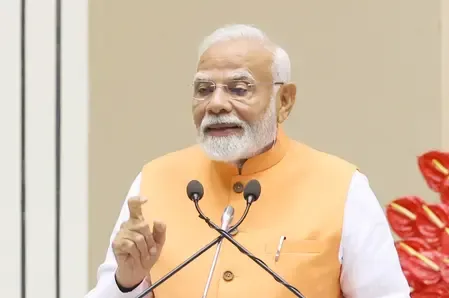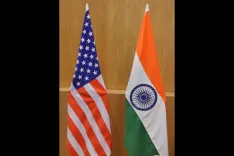Will the Next Decade Strengthen India's Digital Dominance?

Synopsis
Key Takeaways
- Digital India has evolved into a people-centric movement.
- India is transitioning to global digital leadership.
- Over 97 crore internet connections currently exist in India.
- Direct Benefit Transfer has saved Rs 3.48 lakh crore in leakages.
- India ranks among the top three global startup ecosystems.
New Delhi, July 1 (NationPress) As 'Digital India' marks its 10-year milestone, the upcoming decade promises to be even more revolutionary. Prime Minister Narendra Modi emphasized that the country is evolving from a phase of digital governance to a position of global digital leadership—shifting from India-first to India-for-the-world.
PM Modi remarked that 'Digital India' transcended mere governmental initiative; it has transformed into a people's movement. He stated, "It is vital for constructing an 'Aatmanirbhar Bharat' and establishing India as a reliable innovation ally worldwide. To all innovators, entrepreneurs, and dreamers: the world is looking at India for the next digital breakthrough," as shared in his recent LinkedIn update.
A decade ago, India embarked on a courageous expedition into unknown realms with unwavering confidence. While years were spent questioning the capability of Indians to utilize technology, "we altered this narrative and embraced the potential of Indians to leverage technology," PM Modi stated.
He pointed out that decades were spent believing technology would widen the gap between the affluent and the underprivileged, but this mindset was changed. Technology has been employed to bridge the divide instead. When the intent is genuine, innovation empowers the underprivileged. An inclusive approach allows technology to bring about change in the lives of marginalized individuals," PM Modi highlighted.
This conviction laid the groundwork for Digital India—a mission to democratize access, create inclusive digital infrastructure, and offer opportunities to all.
In 2014, internet accessibility was limited, digital literacy was low, and online access to government services was scarce. Many were skeptical about whether a nation as vast and diverse as India could genuinely embrace digital transformation.
"Today, that question has been addressed not only through data and dashboards but in the lives of 140 crore Indians. From governance to education, transactions, and development, Digital India is omnipresent," noted the Prime Minister.
In 2014, India had approximately 25 crore internet connections. Today, this figure has surged to over 97 crores. More than 42 lakh kilometers of Optical Fibre Cable—equivalent to eleven times the distance between Earth and the Moon—now links even the most remote villages.
PM Modi mentioned on LinkedIn that India's 5G rollout is among the swiftest globally, with 4.81 lakh base stations established in just two years.
"High-speed internet now reaches urban centers and forward military posts alike, including Galwan, Siachen, and Ladakh. India Stack, our digital backbone, has facilitated platforms like UPI, which now processes over 100 billion transactions annually. Nearly half of all real-time digital transactions occur in India," the Prime Minister emphasized.
Through Direct Benefit Transfer (DBT), more than Rs 44 lakh crore has been directly transferred to citizens, eliminating intermediaries and saving Rs 3.48 lakh crore in leakages. Initiatives like SVAMITVA have issued over 2.4 crore property cards and mapped 6.47 lakh villages, resolving years of land-related ambiguities, PM Modi stated.
India's digital economy is also empowering MSMEs and small entrepreneurs like never before. The Open Network for Digital Commerce (ONDC) is a groundbreaking platform that opens new opportunities by connecting buyers and sellers seamlessly.
"GeM (Government e-Marketplace) allows common individuals to sell goods and services to all government branches. This not only empowers the common people with a vast market but also saves costs for the government," the Prime Minister stated.
Recently, ONDC surpassed 200 million transactions, achieving the last 100 million in just six months. From Banarasi weavers to bamboo artisans in Nagaland, sellers are now reaching customers nationwide, free from intermediaries and digital monopolies. GeM has also surpassed Rs 1 lakh crore GMV in just 50 days, with 22 lakh sellers, including over 1.8 lakh women-led MSMEs, fulfilling orders worth Rs 46,000 crore.
India's Digital Public Infrastructure (DPI)—from Aadhaar, CoWIN, DigiLocker, and FASTag to PM-WANI and One Nation One Subscription—is now being studied and implemented globally, PM Modi wrote.
CoWIN facilitated the world's largest vaccination drive, issuing 220 crore QR-verifiable certificates. DigiLocker, boasting 54 crore users, securely hosts over 775 crore documents.
"Through our G20 Presidency, India initiated the Global DPI Repository and a $25 million Social Impact Fund, assisting nations across Africa and South Asia in adopting inclusive digital ecosystems," the Prime Minister further noted.
"India now ranks among the top three startup ecosystems globally, with over 1.8 lakh startups. However, this is more than a startup movement; it is a tech renaissance. India excels in AI skill penetration and AI talent concentration among our youth," PM Modi stated.
"With the $1.2 billion India AI Mission, India has facilitated access to 34,000 GPUs at unparalleled prices of less than $1/GPU hour, establishing India not only as the most affordable internet economy but also as the most economical compute destination. India has championed a humanity-first AI approach," PM Modi concluded.






